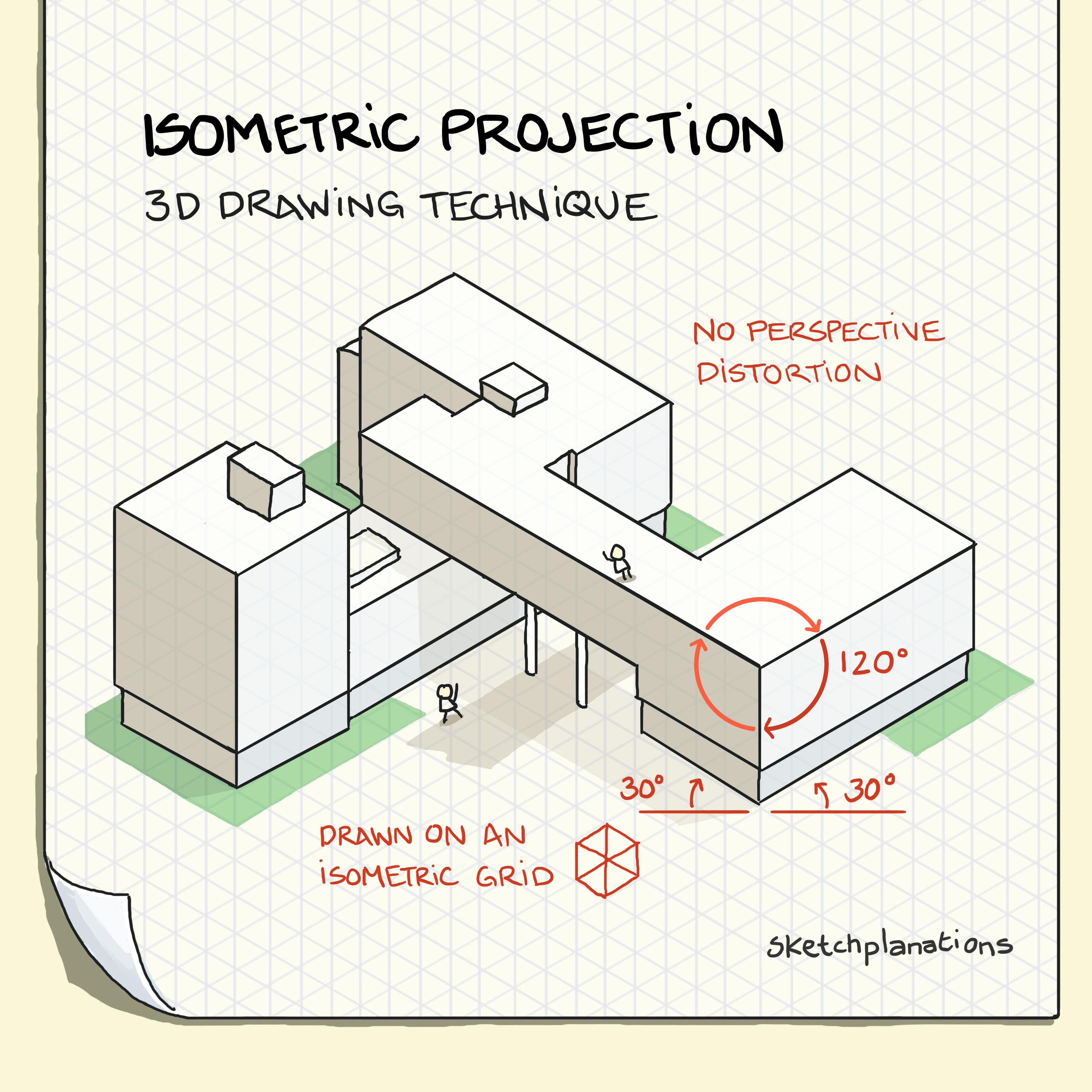Isometric projection

- Prints
- Copied!
👇 Get new sketches each week
What is Isometric Projection?
Isometric projection is a simple way to draw 3D shapes.
The meaning of isometric is "equal measure," from the Greek words iso- for equal and metric for measure. So, in an isometric drawing, all three axes, x, y, and z, are scaled equally, giving a clear, undistorted view of an object in three dimensions.
Isometric Projection vs Perspective Drawing
Except that isometric drawings can look a little odd and oversimplified. This is because of the lack of perspective, a visual distortion of 3D shapes we experience in the real world. In a perspective drawing, parallel lines converge in the distance towards a vanishing point, but in an isometric drawing, parallel lines stay parallel, and sizes don't get smaller in the distance.
The lack of perspective in an isometric view can make it look artificial, but it always looks clear.
Learning Isometric Drawing
I learned isometric drawing when studying engineering. Armed with a stack of isometric paper with a printed isometric grid, we had to reel off exercises involving drawing isometric views of 3D objects. And isometric projection is really handy for this. It can take a long time to build the skills to sketch a realistic 3D-looking object, perspective and all, but with isometric paper, you can quite quickly produce something that communicates to you or others what's in your head or on the workbench.
Isometric projection is handy for boxy shapes—I chose an approximation of the Bauhaus Dessau building by Walter Gropius to show it. If you need curves and angles, just like with perspective drawings, it can help to draw more boxes around these areas and use them to align your curves and meeting points for your lines.
Isometric Views in Games and Media
Isometric views and their variations have experienced a resurgence in recent years in video and board games. It turns out they're pretty helpful in map-based or city-building games, such as Zynga's FarmVille, Civilisation, or SimCity.
The isometric view allows all parts of a scene to be viewed equally—in the distance or up close—while still seeing every detail in, say, a building, wherever it is.
For similar reasons, isometric perspective has also been called God's Perspective, because it equalises all things. It's the view you might have if you were a god looking down on earth and seeing everything perfectly. This is rather fitting for these kinds of games, where you essentially play God to your little civilisations.
Creating Isometric Grid Paper
If you want to try some isometric drawings, making your own isometric grid paper is easy. Just draw equally-spaced vertical stripes and then a criss-cross of lines in both directions at 30 degrees from the horizontal. This gives a host of equilateral triangles and an easy base to start drawing your 3D objects. Or just download some templates online.
You'll find that building up more complex shapes out of cubes is dead simple if you keep to the lines on the isometric grid.
Optical Illusions and Impossible Shapes
Just as in the drawing here, sometimes shapes drawn in isometric view lend themselves to curious optical effects.
The lack of perspective can make the difference between heights and depths ambiguous. So, you can't always tell if two surfaces are at very different heights or if one is in the distance.
The brilliant puzzle game Monument Valley uses this quirk of isometric projection to create mind-bending puzzles that are well worth a try. For instance, rotating a high surface can suddenly make a platform that extends far into the distance 🤯.
Isometric-like projection can also help make impossible shapes, such as the Impossible Staircase, or Penrose stairs. Another type of projection, anamorphosis, creates a drawing that appears correct only from a particular viewpoint. Anamorphosis leads to some remarkable street art.
Related Ideas to Isometric Projection
Also see:
- 2.5D objects, including an old video of me drawing a sketchplanation
- Orthographic projection
- One-point perspective
- Two-point perspective
- Three-point perspective
- Atmospheric perspective
- Anamorphosis
- The Impossible Staircase, or Penrose stairs
- When drawn nice and faint, the isometric grid is an example of a ghost grid
- Isometric projection is quite the opposite of "draw what you see, not what you think." Foreshortening can be hard to get the hang of.
- Life is 3D—give edges thickness

